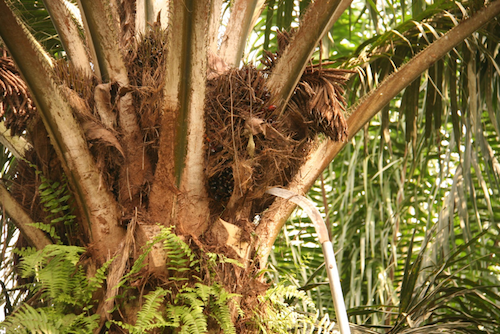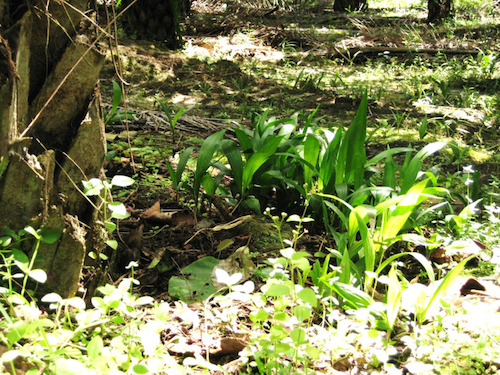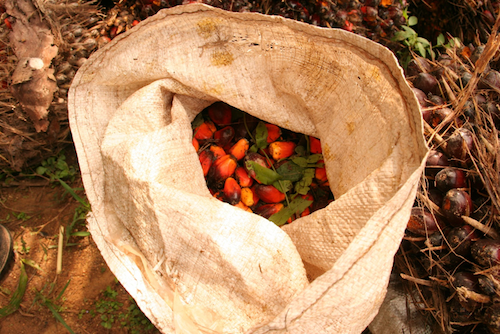Difference between revisions of "Sustainable Oil Palm Farming / Harvesting"
(Published from sandbox) |
(No difference)
|
Revision as of 22:31, 10 October 2016
Download: Module 2: Harvesting, Grading, Transport
Contents
Goal
- Be able to cut and collect all ripe fruit bunches in a plantation;
- Be able to harvest fresh fruit bunches without damaging the fruit and the palm;
- Be able to get fresh fruit bunches with excellent oil content and quality;
- Be able to get maximum profit from harvested fresh fruit bunches.
Standard
- All ripe fruit bunches are harvested at every harvesting round;
- Harvesting is done at least once every 10 days;
- Bunches are harvested at the right time and ripeness and in the right way, without causing damage to the bunch and the palm;
- The minimum ripeness standard of 1—4 loose fruits per bunch is followed (only if harvesting is done at least every ten days);
- Stalks are cut to less than 2 cm in length;
- The quantity of harvested fresh fruit bunches is correctly recorded at each harvest.
Timing
All year round.
Frequency
- Once every 7—10 days;
- Note: Many farmers harvest once every two weeks, but this will not give the maximum bunch yield. Some bunches will get overripe during the waiting period, and loose fruits are more likely to get scattered on the ground, so they take more time to collect and some will be lost amongst the weeds. Harvesting more frequently is the fastest and easiest way to improve the yield 1.
Labour time required
- Harvesters work most efficiently in teams organised into the following roles:
- - One person for harvesting and frond stacking;
- - One person for collecting the fresh fruit bunches, cutting off long stalks, stacking bunches by the roadside and marking them (if necessary);
- - One person for collecting loose fruits (can be the same person as the one who collected the fresh fruit bunches).
- The speed of harvesting depends on the palm age [2]:
- - Palms less than 5 years after planting: around 300 bunches per harvesting team per day;
- - Palms between 6—12 years after planting: 150 to 200 bunches per harvesting team per day;
- - Palms more than 12 years after planting: 100 to 150 bunches per harvesting team per day.
- In the low season less bunches per day can be harvested because it takes more time to walk and search for bunches.
Materials and equipment
- Long pole with harvesting sickle, or chisel (for palms up to 2—3 m tall);
- Axe or bush knife to chop the frond and the stalk;
- Wheelbarrow or bicycle with buckets to transport the fresh fruit bunches;
- Hook or stake to pick up and move the fresh fruit bunches;
- Crayon (or similar) to mark the fresh fruit bunch stalks;
- Empty fertiliser bags to collect the loose fruit.
Who
Farmers and their families or specialist hired labourers.
How
Harvesting should be done according to the following guidelines using the proper tools:
| Step 1. | Identify ripe bunches ready for harvesting based on the loose fruits that are lying in the weeded circle around the palm trunk or are stuck behind frond butts on the trunk. Just looking at the colour of the bunches is not a good way to harvest tall palms because the bunch may look red but they could still be unripe.
A bunch should only be harvested if there is at least one loose fruit on the ground or stuck behind the frond butts on the trunk (minimum ripeness standard) for mature palms. If the bunch looks ripe but there are no loose fruits, shake it with the harvesting pole (without damaging it) to check if any loose fruits fall out. When there are one or several loose fruits, it is certain that the bunch is ripe enough for harvesting. Using the ‘minimum ripeness standard’ of one or two loose fruit will help prevent deductions at the mill for unripe or underripe bunches. Note: When harvesting only twice per month, the minimum ripeness standard will results in many overripe bunches. In this case it is better to harvest based on bunch colour! |
| Step 2. | Harvest the bunch by first cutting a frond according to the following rule of thumb:
|
| Step 3. | Chop the frond into two pieces. Place the spiny, thick bottom part behind the palm, on the frond stack between the rows, and place the thin bottom part between the palm and its neighbour to the right or left (see Module 3: Plantation Maintenance, Pruning, Figure 23). |
| Step 4. | Cut the bunch stalk so that the bunch falls to the ground (see Figure 4). Cut the bunch stalk as shortly as possible (maximum 2 cm). |
| Step 5. | Collect the harvested bunches with a wheelbarrow after one or two rows of palms have been harvested. Ensure all loose fruits are collected, including the loose fruits that are stuck behind the frond butts and those that are lying outside the weeded circle.
Remember:
|
| Step 6. | Move collected fresh fruit bunches and loose fruit to the collection area at the roadside. |
| Step 7 | Stack the fresh fruit bunches into rows. The stack should have only one layer so the bunches can be counted and sorted immediately (see Figure 6). |
| Step 8. | Collect loose fruit separately and place beside the fruit bunches (see Figure 7). |
| Step 9 | Tentative: Label fresh fruit bunches on the cut edge of the stalk with carpenter’s pencils or crayons to indicate their origin. It is best to use a different one-letter code for each field. Every bunch should be marked, and also the fertiliser bags with loose fruit. |
Data Recording
Proper yield recording is discussed and demonstrated in the next section. In addition, to keep track of the labour costs, every harvesting activity should be recorded in a logbook as shown in the example below.
| Date | Time | Location | Activity | Input type | Input amount | Input costs | Labour input | Labour costs | |
| People | Hours | ||||||||
| 16/01/13 | 07.00 16.00 |
Field 3 | Harvesting | 2 | 8 | 120000 | |||
References
- ↑ C.R. Donough, J. Cock, T. Oberthür, K. Indrasuara, A.R. Gatot, T. Dolong, Estimating oil content of commercially harvested oil palm fresh fruit bunches - A step towards increasing palm oil yields, Poster presented at the PIPOC 2013 International Palm Oil Congress and Exhibition, 19—21 November 2013, Kuala Lumpur, Malaysian Palm Oil Board (MPOB), 2013, pages.
Acknowledgements
The material from Harvesting is sourced from Smallholder Oil Palm Handbook and put together by Lotte Suzanne Woittiez (Wageningen Universit) and Haryono Sadikin, Sri Turhina, Hidayat Dani, Tri Purba Dukan, and Hans Smit (SNV) in August 2016. See Module 2: Harvesting, Grading, Transport for more information.







